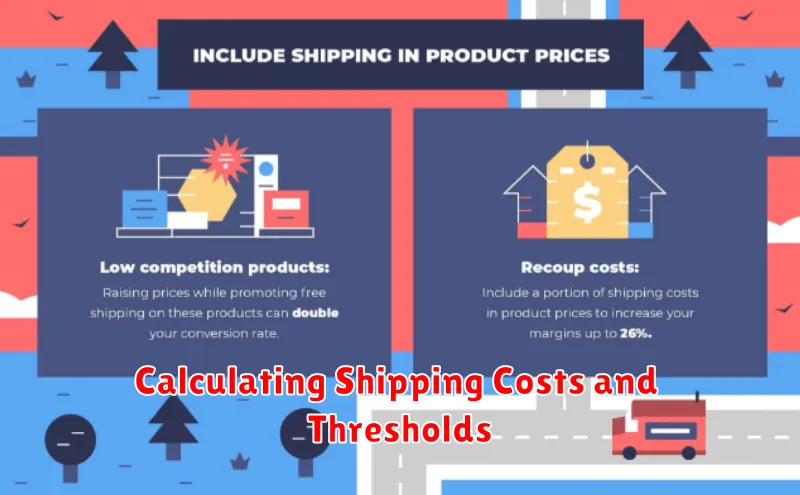Offering free shipping is a popular tactic for online stores, often seen as a powerful incentive to attract customers and boost sales. The allure of free shipping can be undeniable for online shoppers, eliminating that extra cost that can sometimes make or break a purchase. However, absorbing shipping costs can have a significant impact on your bottom line. This article will delve into the complexities of free shipping, weighing the pros and cons to help you determine the optimal strategy for your online store.
Understanding the true cost of free shipping and its potential effects on profitability is crucial for any online store owner. While free shipping can drive conversions and increase average order value, it also introduces logistical and financial considerations. We will examine the various pros and cons, including the potential impact on customer perception, pricing strategies, and overall profitability, to help you navigate the decision of whether or not to offer free shipping for your online store.
The Allure of Free Shipping for Customers
Free shipping is a powerful incentive for online shoppers. It removes a significant barrier to purchase, creating a more streamlined and enjoyable shopping experience.
Eliminating extra costs is a major draw. Customers appreciate knowing the final price upfront without unexpected additions at checkout. This transparency builds trust and encourages them to proceed with their purchase.
Perceived value plays a role as well. Free shipping can make a product seem more affordable, even if the base price is slightly higher than competitors. It’s often viewed as a bonus or a special deal, increasing the likelihood of conversion.
Reduced cart abandonment is another benefit from a customer perspective. Shipping fees are a common reason shoppers abandon their carts. By offering free shipping, businesses can mitigate this issue and recapture lost sales.
Increased Sales and Average Order Value
Offering free shipping can significantly impact both sales volume and average order value. Customers are more likely to complete a purchase if they don’t have to factor in additional shipping costs, potentially leading to a boost in overall sales.
Free shipping can also encourage customers to add more items to their cart to reach a minimum order value for the free shipping offer. This can drive up the average order value, contributing directly to increased revenue. Customers who might have otherwise abandoned their carts due to shipping costs may be incentivized to spend more to qualify for the free shipping promotion.
Key takeaway: By eliminating a perceived barrier to purchase (shipping costs), businesses can see a measurable increase in both the number of transactions and the amount spent per transaction.
Competitive Advantage in the Market
In today’s e-commerce landscape, free shipping can be a powerful differentiator. Many online shoppers prioritize free shipping when making purchasing decisions, and offering it can give your store a significant edge over competitors who don’t.
Free shipping can be especially effective in attracting price-sensitive customers. By absorbing the shipping cost, you’re effectively lowering the overall price of your products, making them more appealing to budget-conscious buyers. This can lead to increased market share and brand loyalty as customers are drawn to the perceived value.
Moreover, free shipping promotions can create a sense of urgency and encourage impulse purchases. Customers may be more inclined to add items to their cart to reach a free shipping threshold, boosting your average order value.
The Hidden Costs of Free Shipping
While free shipping is a powerful incentive for customers, it’s crucial to understand the costs involved for your business. Offering free shipping doesn’t mean shipping is actually free; someone has to absorb those expenses.
Absorbed Shipping Costs: The most direct cost is the actual shipping fee paid to carriers. This varies based on package weight, dimensions, destination, and shipping speed. Offering free shipping means your business directly absorbs these costs, reducing your profit margins on each sale.
Increased Handling & Packaging Costs: Free shipping can often lead to increased order volume, requiring more packaging materials and labor for order fulfillment. This can strain existing resources and necessitate additional investments in staffing and materials.
Return Shipping Costs: Free shipping can inadvertently encourage more returns. If you offer free return shipping as well, these costs can quickly accumulate and cut into your bottom line.
Impact on Profit Margins
While free shipping can boost sales, it directly impacts profit margins. Absorbing shipping costs cuts into the revenue earned per item. This is especially significant for businesses with low-margin products where the shipping cost might represent a substantial portion of the profit.
Businesses must carefully analyze their cost structure to determine the feasibility of free shipping. Factors to consider include average shipping costs, product price points, and sales volume. If not managed effectively, offering free shipping can lead to reduced profitability or even losses, despite higher sales figures.
Strategies for mitigating the impact on profit margins include increasing product prices slightly, setting minimum order values for free shipping eligibility, or offering free shipping during promotional periods only. A detailed cost-benefit analysis is crucial before implementing a free shipping policy.
Calculating Shipping Costs and Thresholds

Accurately calculating shipping costs is crucial before offering free shipping. Factor in package weight, dimensions, destination, and shipping carrier rates. Use online shipping calculators or integrate with carrier APIs for real-time cost estimates.
Establishing a free shipping threshold involves determining the minimum order value that qualifies for free shipping. This threshold needs to offset shipping costs while still being attractive to customers. Analyze your product margins and average order value to arrive at a profitable threshold.
Consider using a tiered system. For example, offer free shipping on orders over $50, and a discounted rate for orders between $25 and $50. This can encourage customers to increase their basket size to reach the free shipping level.
Continuously monitor and adjust your shipping costs and thresholds as needed. Carrier rates can change, and your average order value might fluctuate. Regular review ensures your free shipping offer remains sustainable for your business.
Strategies for Offering Free Shipping Effectively
Offering free shipping effectively requires careful planning and execution. Strategic implementation is key to maximizing benefits while minimizing potential losses.
Membership programs can be a powerful tool. Offering free shipping as a perk for members encourages loyalty and repeat purchases. This allows you to recoup shipping costs over time.
Product bundling is another useful strategy. By combining items into bundles, you increase the average order value, making free shipping more financially viable. This can also encourage customers to purchase more items than they originally intended.
Finally, consider conditional free shipping. This involves offering free shipping when specific criteria are met, such as a minimum order value or purchase of certain items. This incentivizes customers while allowing you to control costs.
Setting Minimum Order Values
A strategic approach to mitigating the costs of free shipping involves setting minimum order values. This means customers must reach a specified purchase amount to qualify for free shipping. This encourages larger purchases, potentially offsetting shipping expenses and increasing your average order value.
Determining the right minimum order value is crucial. Analyze your current average order value and product margins to find a sweet spot that encourages higher spending without deterring potential customers. Consider the following:
- Product Pricing: If your products are generally lower priced, a lower minimum order value might be more effective.
- Shipping Costs: Factor in your average shipping costs to ensure the increased order value adequately covers these expenses.
- Competitor Analysis: Research your competitors’ free shipping thresholds to understand the prevailing market standards.
Testing different minimum order values can help you find the optimal balance between attracting customers and maintaining profitability.
Promotional Free Shipping Campaigns
Strategically timed free shipping promotions can create excitement and drive sales. Consider these promotional campaign ideas:
Limited-Time Offers
Create a sense of urgency with free shipping for a limited time, like a weekend or a holiday period. This encourages immediate purchases.
Holiday Specials
Offer free shipping during peak shopping seasons like Black Friday, Cyber Monday, or around Christmas to capitalize on increased consumer spending.
First-Time Customer Incentive
Attract new customers by offering free shipping on their first purchase. This can be a powerful incentive to try your products.
Free Shipping Threshold Promotions
Occasionally lower your free shipping threshold. For example, instead of free shipping on orders over $75, offer it on orders over $50 for a limited time.
Product-Specific Promotions
Offer free shipping on specific products or product categories to clear out inventory or promote new items.
Transparency with Customers

Clear communication about your shipping policies is crucial for building trust and avoiding customer frustration. Be upfront about how free shipping is earned, whether it’s through a minimum purchase, a special promotion, or a membership program.
Clearly display the free shipping threshold on your website. Consider placing it in your banner, FAQ section, and prominently on product pages. This prevents confusion at checkout and encourages customers to meet the requirements for free shipping.
Explain any restrictions that apply. For example, if free shipping is only available within a certain geographical area, or for specific products, state this information clearly. This prevents surprises and maintains customer satisfaction.
If you offer different shipping tiers, explain the cost and estimated delivery time for each option. A clear comparison chart can help customers make informed decisions about their shipping preferences.

